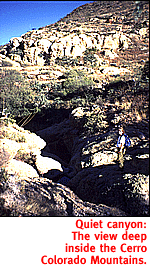
Navigating The Wilds Of Arizona? Be Sure To Take Your Paper Clip.
By Kevin Franklin
THROUGHOUT HISTORY, GREAT advances in exploration move
hand in hand with new navigational technologies.
 The compass allowed sailors to move away from the coastline in
foul weather and still keep their bearing. The sextant enabled
trans-Atlantic explorers to chart their movements. Most recently,
global positioning system units have given hikers their precise
location by satellite.
The compass allowed sailors to move away from the coastline in
foul weather and still keep their bearing. The sextant enabled
trans-Atlantic explorers to chart their movements. Most recently,
global positioning system units have given hikers their precise
location by satellite.
But my favorite navigational tool is the paper clip. It's lighter
than a compass, more durable than a sextant and considerably cheaper
than a GPS unit. They even come in different colors.
Lost my mind? Not hardly, though I do have to admit that without
an odometer and a map, the paper clip is worthless as a navigational
tool. You see, by taking a paper clip and marking it to match
the hash marks on your map's mileage key, you can easily plot
distances on the map.
For instance, say two inches on your map equals six miles. You
take two inches of your paper clip, bend it into a pattern matching
the squiggly line of a road you're trying to follow, and, voila!
You know how many miles it is from point A to point B. When you
ring up six miles on your odometer, you should be at point B.
This may sound somewhat anal--after all, with a map you should
be able to just look around and figure out where you are. But
a recent Out There adventure to the Cerro Colorado Mountains northeast
of Arivaca proves the exception.
We know we have to make a left turn onto a dirt track, and the
distance from Batamote Ranch is a little under two-and-a-half
miles. It all looks simple on paper, but weathered roads show
blatant disregard for the intentions of cartographers. New roads
spring up, old roads fade away. Simple instructions like, "take
the first left," yield to problems like, "this is the
first left, but the road seems too small and doesn't quite match
the map."
 Fortunately, Out There's stumble luck holds, and we follow a
series of other roads back to the point we wanted to reach from
the first road. But here's where we need another handy navigational
tool, the copy machine.
Fortunately, Out There's stumble luck holds, and we follow a
series of other roads back to the point we wanted to reach from
the first road. But here's where we need another handy navigational
tool, the copy machine.
The particular stretch of road we want to follow is smack dab
in the middle of four topographical maps. Imagine trying to shuffle
back and forth between four maps on a breezy day. Placing your
maps on the copy machine and making a new, hybrid map, especially
a smaller one, will alleviate a great deal of frustration.
Despite my inability to follow my own advice, we wind our
way into the heart of the Cerro Colorado Mountains. These cliffy
outcrops and thrusting spires are mostly solidified volcanic ash
and reddish rhyolite. Ancient eruptions, violent and explosive,
have now become an overlooked Arizona backwater. What I like about
the Cerro Colorados is their quiet magnificence. Fantastic rock
formations, beautiful mesquite forests and deep grass all hide
in the heart of the range. Yet they are left, for the most part,
to a few hunters and the local ranching outfit.
We park the truck just past Wino Tank and begin hiking up the
canyon. A cow track runs along the canyon bottom for about a half
mile. After that, the trail reappears intermittently, but for
the most part the hike is a bushwhack. About a mile in, the canyon
splits. We take the right fork. Shortly thereafter we enter a
stretch of shallow pools and channels cut into the rock by a millennium
of erosion. It's a miniature Slickrock Canyon.
Up ahead the route comes to an end in a box canyon. Climbing
the walls of the canyon would give us a view of Las Guijas Mountains
and Arivaca to the south, but the shadows are growing long. We
head back to the truck and dinner underneath a starry sky and
among the cliffs of Cerro Colorado.
Getting There
Take Interstate 19 south to Exit 48, Arivaca Junction. Head west.
Just past milemarker 19, take Batamote Road to the right. Stay
on the main track, bearing left at the fork two miles in. Continue
to Batamote Ranch on your left. Pass through the ranch, making
sure to leave gates as you found them, and look for the road on
your left, a little less than two-and-half miles on, and continue
to Wino Tank.
Mapage
Saucito Mtn., Cerro Colorado, Peñitas Hills and Batamot
Hills 7-1/2 minute topographical maps will get you there in style.

|
